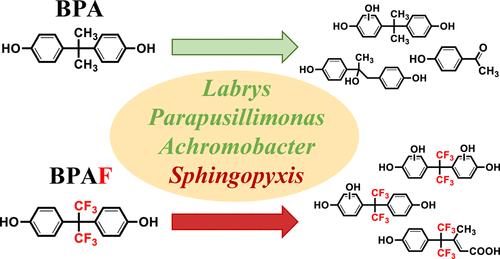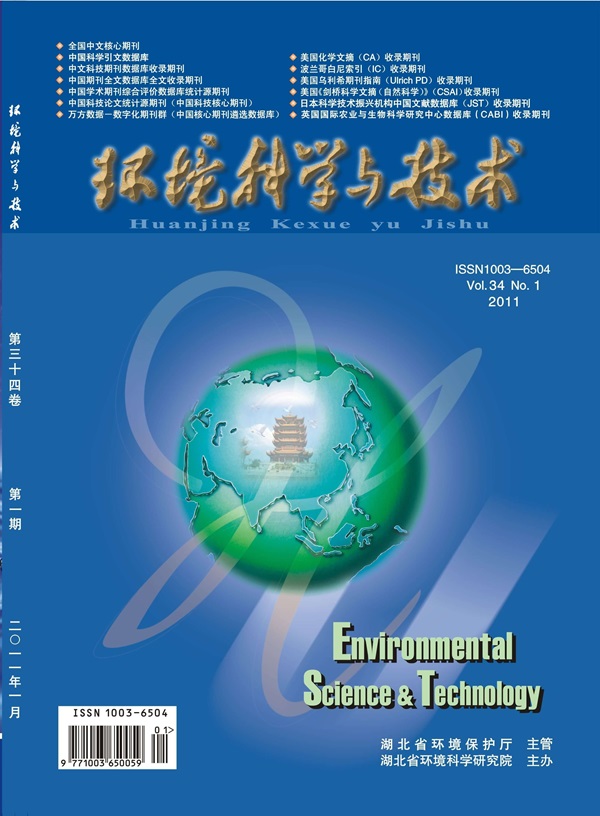Co-metabolic Biotransformation of Bisphenol AF by a Bisphenol A-Growing Bacterial Enrichment Culture
IF 11.3
1区 环境科学与生态学
Q1 ENGINEERING, ENVIRONMENTAL
引用次数: 0
Abstract
The fluorinated bisphenol A (2,2-bis[4-hydroxyphenyl]propane, BPA) substitute bisphenol AF (BPAF) could be more persistent and toxic than BPA, but little is known about its environmental fate. In this study, we established a co-metabolic BPAF-degrading bacterial enrichment culture with BPA as the growth substrate. BPAF degradation by the enrichment culture was dependent on BPA, and BPAF could be eliminated to below the detection limit with successive additions of BPA. BPAF was mainly degraded via phenolic ring hydroxylation and sequential ring cleavage, which are minor BPA transformation pathway. Conjugated BPAF products were also identified based on the characteristic CF3– fragment and were found to accumulate during BPAF degradation. Sphingopyxis was the key BPA and BPAF degrader in the aerobic enrichment cultures, which was the most abundant genera in only BPA-added and BPA and BPAF-added cultures and was proven to be able to degrade BPA and BPAF by isolation. The aerobic co-metabolic BPAF degrading community also contain non-BPA and BPAF degraders, such as Pandoraea, which may play a supporting role in the community.

双酚a细菌富集培养双酚AF的共代谢生物转化
氟化双酚A(2,2-双[4-羟基苯基]丙烷,BPA)替代品双酚AF (BPAF)可能比BPA更具持久性和毒性,但对其环境命运知之甚少。在本研究中,我们建立了以双酚a为生长底物的双酚a降解细菌富集培养物。富集培养对BPAF的降解依赖于BPA,随着BPA的不断添加,BPAF可被去除至检测限以下。BPAF主要通过酚环羟基化和序环裂解降解,这是次要的BPA转化途径。根据CF3 -片段的特征,还鉴定了共轭BPAF产物,并发现在BPAF降解过程中积累。Sphingopyxis是好氧富集培养中降解BPA和BPAF的关键菌属,在仅添加BPA和添加BPA和BPAF的培养中含量最多,经分离证实具有降解BPA和BPAF的能力。有氧共代谢BPAF降解菌群中还含有非双酚a和双酚a降解菌,如潘多拉菌,可能在该菌群中起辅助作用。
本文章由计算机程序翻译,如有差异,请以英文原文为准。
求助全文
约1分钟内获得全文
求助全文
来源期刊

环境科学与技术
环境科学-工程:环境
CiteScore
17.50
自引率
9.60%
发文量
12359
审稿时长
2.8 months
期刊介绍:
Environmental Science & Technology (ES&T) is a co-sponsored academic and technical magazine by the Hubei Provincial Environmental Protection Bureau and the Hubei Provincial Academy of Environmental Sciences.
Environmental Science & Technology (ES&T) holds the status of Chinese core journals, scientific papers source journals of China, Chinese Science Citation Database source journals, and Chinese Academic Journal Comprehensive Evaluation Database source journals. This publication focuses on the academic field of environmental protection, featuring articles related to environmental protection and technical advancements.
 求助内容:
求助内容: 应助结果提醒方式:
应助结果提醒方式:


